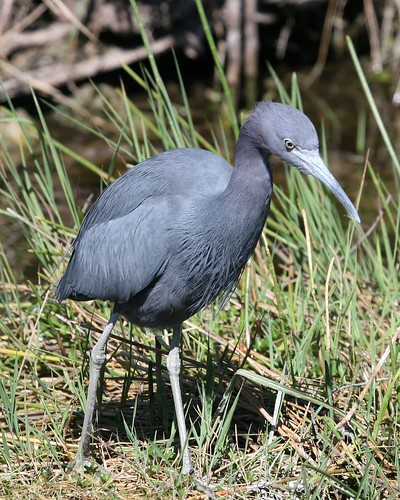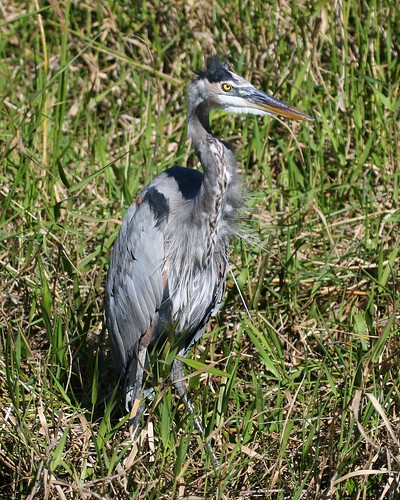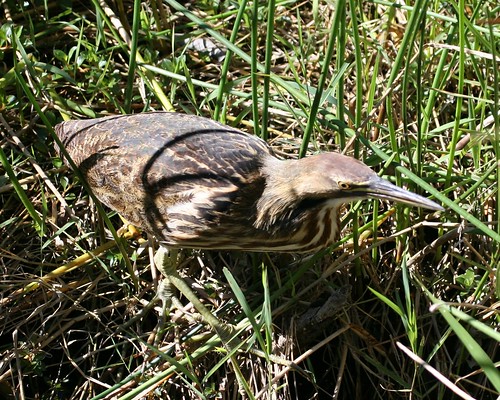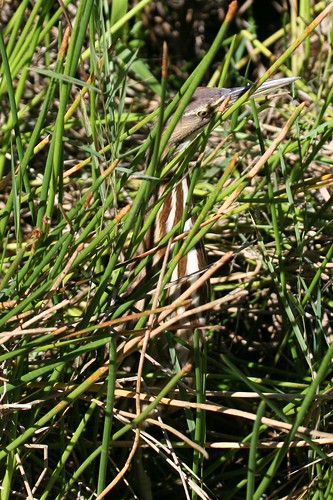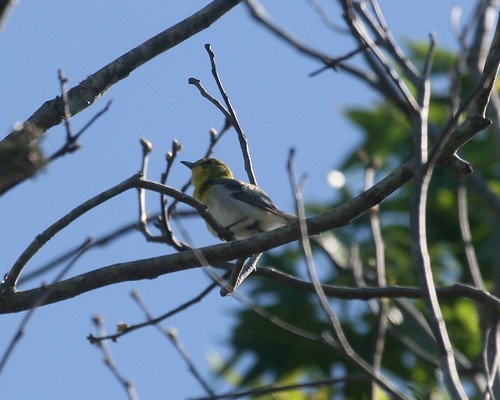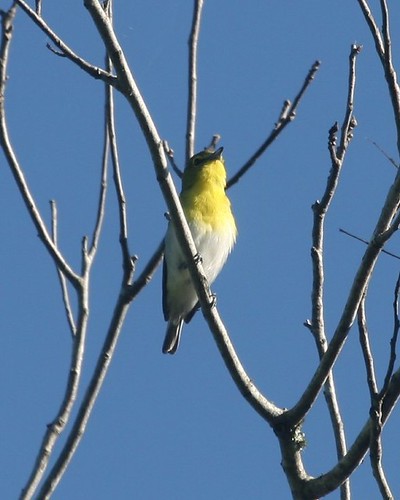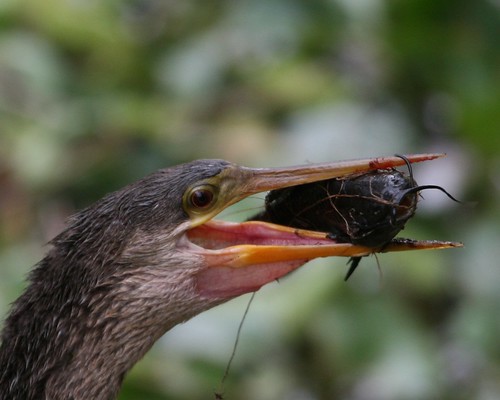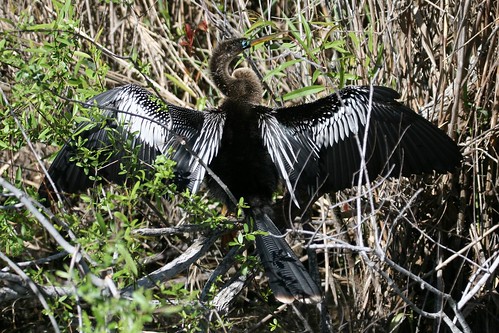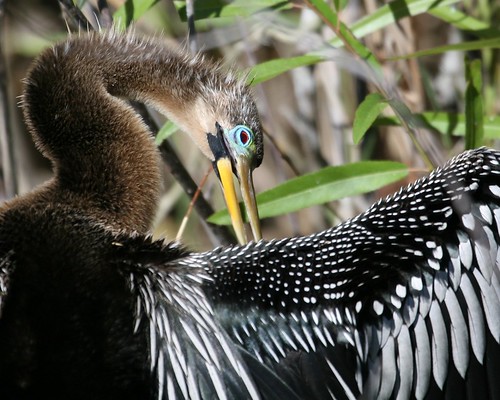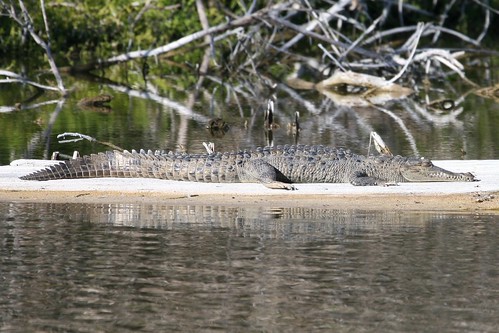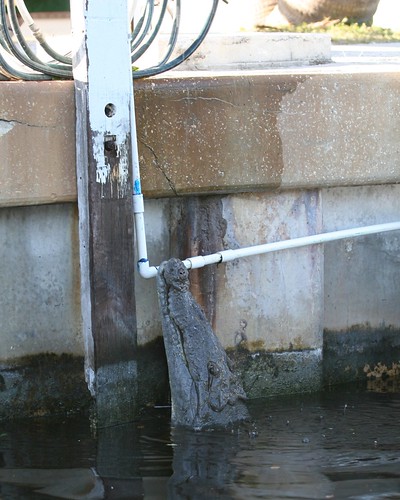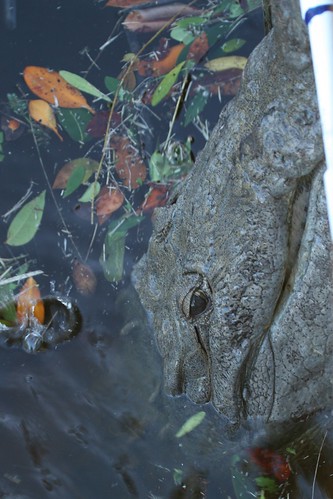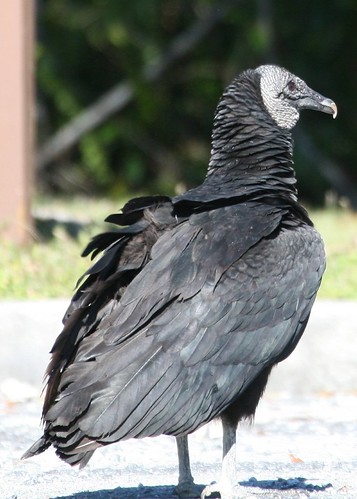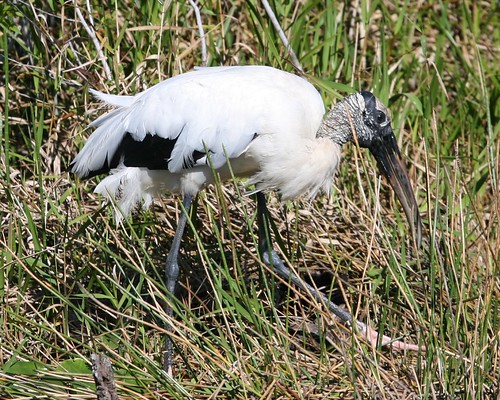The name Little Blue Heron makes that species sound like the little brother of the Great Blue Heron. If you are comparing the Little Blue to the Great Blue, then yes...it is true that the Little Blue is "little", but it is not really a small bird. And while both the Little Blue and the Great Blue do have blue coloration (most of the time), the Great Blue really seems more gray to me, and the Little Blue is leaning towards purple (or, maybe it is indigo).
Regardless of the idiosyncrasies of his common name, the Little Blue Heron is a beautiful bird. Here is a photo of an adult, in all his blue-ish glory, found near the Anhinga Trail within Everglades National Park. He appears to be very serious about finding his next meal.
Great Blue Heron
Great Blue Herons are pretty common birds. I can find them year round in Virginia, so seeing them in Florida is never really a priority. But they are such good subjects for photography. They are large, so you don't have to worry much about being too far away. And, they are usually very still or slow moving, so you don't have to fight to keep them in frame or focus.
I like this photo of a Great Blue Heron. He looks a bit wind blown, and that yellow eye makes him look a bit grumpy.
I like this photo of a Great Blue Heron. He looks a bit wind blown, and that yellow eye makes him look a bit grumpy.
American Bittern
While Tammy and I were on Anhinga Trail in Everglades National Park we were lucky enough to notice an American Bittern standing in the tall grass just next to the boardwalk. An American Bittern likes to sit verrrry still. This behavior, combined with its striped color pattern, gives it a very effective disguise in tall grass and reeds. It is very easy to walk right past this species and never notice it.
Like most parks that are easily accessed by lots of people, the majority of the wildlife goes unnoticed by the masses. This was the case on Anhinga Trail. Everyone "oooohed" and "ahhhed" over the large birds and the alligators that were impossible not to see. But hardly anyone noticed the small song birds, or this American Bittern. Only when someone stops to take photos, or obviously pay attention to some creature, will others stop to see what the fuss is all about. This phenomenon is the same as the traffic jams that I described in Yellowstone National Park.
Here are a couple photos of the American Bittern. Maybe some of the folks who saw me perched on the edge of the boardwalk taking pictures of this bird will remember that they completely missed this animal's presence. And then maybe they will wonder just how many other things they are missing. If you don't know something is there, then it is probable that you are not thinking about conserving it.
Like most parks that are easily accessed by lots of people, the majority of the wildlife goes unnoticed by the masses. This was the case on Anhinga Trail. Everyone "oooohed" and "ahhhed" over the large birds and the alligators that were impossible not to see. But hardly anyone noticed the small song birds, or this American Bittern. Only when someone stops to take photos, or obviously pay attention to some creature, will others stop to see what the fuss is all about. This phenomenon is the same as the traffic jams that I described in Yellowstone National Park.
Here are a couple photos of the American Bittern. Maybe some of the folks who saw me perched on the edge of the boardwalk taking pictures of this bird will remember that they completely missed this animal's presence. And then maybe they will wonder just how many other things they are missing. If you don't know something is there, then it is probable that you are not thinking about conserving it.
Yellow-throated Vireo
As I have been re-organizing my photo collection within Flickr, I have occasionally come across a picture or two that are fairly good, but somehow I missed when I first uploaded them. An example are these photos of a Yellow-throated Vireo that I took back in April 2007 while I was in Louisiana. These were taken in Lake Fausse Point State Park. If my memory is correct, this little guy was singing and preening all morning long in a tree next to the parking lot.
Another Anhinga...this one is hungry
One of the places that Tammy and I visited while in Florida was Corkscrew Swamp Sanctuary. If you enjoy bird watching, and are ever in south Florida, then Corkscrew should be on your agenda. It is too good to miss.
While in Corkscrew, we came across an Anhinga in the act of fishing. It dove into the marsh and swam around under the lily pads, occasionally sticking its beak up out of the water and lily pads (I guess for a bit of air). Eventually it came back to its roost (a log on some dry ground next to the marsh) with a fish to eat. The fish, however, was impaled on its upper mandible.
The Anhinga then spent the next few minutes flailing about, beating the fish on that log, in an attempt to knock the fish off its beak. When it finally succeeded, it got down to the business of getting the fish oriented properly so that it could go down the hatch. Mmmmmm...good eats!
While in Corkscrew, we came across an Anhinga in the act of fishing. It dove into the marsh and swam around under the lily pads, occasionally sticking its beak up out of the water and lily pads (I guess for a bit of air). Eventually it came back to its roost (a log on some dry ground next to the marsh) with a fish to eat. The fish, however, was impaled on its upper mandible.
The Anhinga then spent the next few minutes flailing about, beating the fish on that log, in an attempt to knock the fish off its beak. When it finally succeeded, it got down to the business of getting the fish oriented properly so that it could go down the hatch. Mmmmmm...good eats!
Anhinga
When in Florida, you are almost certain to see an Anhinga at some point. When traveling on Anhinga Trail within the Everglades, your odds get even better. Often you will see Anhinga perched in a bush or tree, or even on something like a light pole, with their black and silvery wings spread out, as if someone had hung them out to dry on an invisible clothesline. Ironically, that is not very far from the truth.
Anhinga do not have waterproofed feathers (unlike ducks). This allows them to swim under water in search for food. But when they do exit the water, they need to dry their feathers to make flying easier (or possible).
Here are a couple of photos of an Anhinga taken from Anhinga Trail. The first shows the typical drying pose. The second is a close-up of the face that highlights the greenish color of the facial skin that males acquire during breeding.
You may notice that these photos are smaller than the photos that have previously appeared in this blog. This is simply a factor of the time required to manage my photos and post entries to this blog. My previous photo hosting choice (Phanfare) automatically gave me pictures that were resized to be 700 pixels on the long side. My new photo hosting choice (Flickr) automatically gives me pictures that are resized to be 500 pixels on the long side. I have been telling myself that I will continue to manually create resized pictures in Flickr that are my usual 700 pixels on the long side, but this appears to be taking more time that I would like, and it has the side-effect of creating clutter within my photo collection at Flickr. So, for now, I will be putting my blogged pictures on a diet, and linking in the 500 pixel version. If you click on a picture, you will be redirected to that photo within my collection at Flickr, where you can see lots of other sizes of the photo (all constructed automatically by Flickr), look at other photos from me, leave comments on specific pictures, and all kinds of other Flickr goodness.
Anhinga do not have waterproofed feathers (unlike ducks). This allows them to swim under water in search for food. But when they do exit the water, they need to dry their feathers to make flying easier (or possible).
Here are a couple of photos of an Anhinga taken from Anhinga Trail. The first shows the typical drying pose. The second is a close-up of the face that highlights the greenish color of the facial skin that males acquire during breeding.
You may notice that these photos are smaller than the photos that have previously appeared in this blog. This is simply a factor of the time required to manage my photos and post entries to this blog. My previous photo hosting choice (Phanfare) automatically gave me pictures that were resized to be 700 pixels on the long side. My new photo hosting choice (Flickr) automatically gives me pictures that are resized to be 500 pixels on the long side. I have been telling myself that I will continue to manually create resized pictures in Flickr that are my usual 700 pixels on the long side, but this appears to be taking more time that I would like, and it has the side-effect of creating clutter within my photo collection at Flickr. So, for now, I will be putting my blogged pictures on a diet, and linking in the 500 pixel version. If you click on a picture, you will be redirected to that photo within my collection at Flickr, where you can see lots of other sizes of the photo (all constructed automatically by Flickr), look at other photos from me, leave comments on specific pictures, and all kinds of other Flickr goodness.
American Crocodile
While inside Everglades National Park, we saw plenty of American Alligators. I was assuming, however, that all of the large alligator-looking reptiles were, well...alligators. My assumption was quite wrong. It turns out that the only place in the world where you can see alligators and crocodiles in the same habitat is South Florida.
Tammy and I took a stroll around Eco Pond, near Flamingo, and there was an alligator laying out in the sun on a piece of wood. We overheard another person, however, talking about the crocodile. When we inquired about our apparent misidentification, we learned that what we thought was just one more alligator was, in fact, an American Crocodile. Later we got word that there was another crocodile hanging around the marina in Flamingo. When we checked it out, we were delighted to see another American Crocodile poking its head up out of the water under the dripping sprayer on a hose, almost like it enjoyed the mini-shower.
Tammy and I took a stroll around Eco Pond, near Flamingo, and there was an alligator laying out in the sun on a piece of wood. We overheard another person, however, talking about the crocodile. When we inquired about our apparent misidentification, we learned that what we thought was just one more alligator was, in fact, an American Crocodile. Later we got word that there was another crocodile hanging around the marina in Flamingo. When we checked it out, we were delighted to see another American Crocodile poking its head up out of the water under the dripping sprayer on a hose, almost like it enjoyed the mini-shower.
Bald Headed Birds
Tammy and I visited Everglades National Park one day this week to check out the wildlife. One of our stops in the park was Anhinga Trail, where we found lots of birds and alligators. Two of the more abundant species of bird were Black Vulture and Wood Stork, neither of which have feathers on their head. Yeah, they are ugly, but they are still cool birds.
Perhaps it was the RV parking area, or maybe a nearby dumpster, but the vultures seemed to enjoy hanging out in the parking lot. The storks were scattered along the trail, anywhere there was shallow marshy water for them to poke about in search of food.
Perhaps it was the RV parking area, or maybe a nearby dumpster, but the vultures seemed to enjoy hanging out in the parking lot. The storks were scattered along the trail, anywhere there was shallow marshy water for them to poke about in search of food.
Subscribe to:
Posts (Atom)
